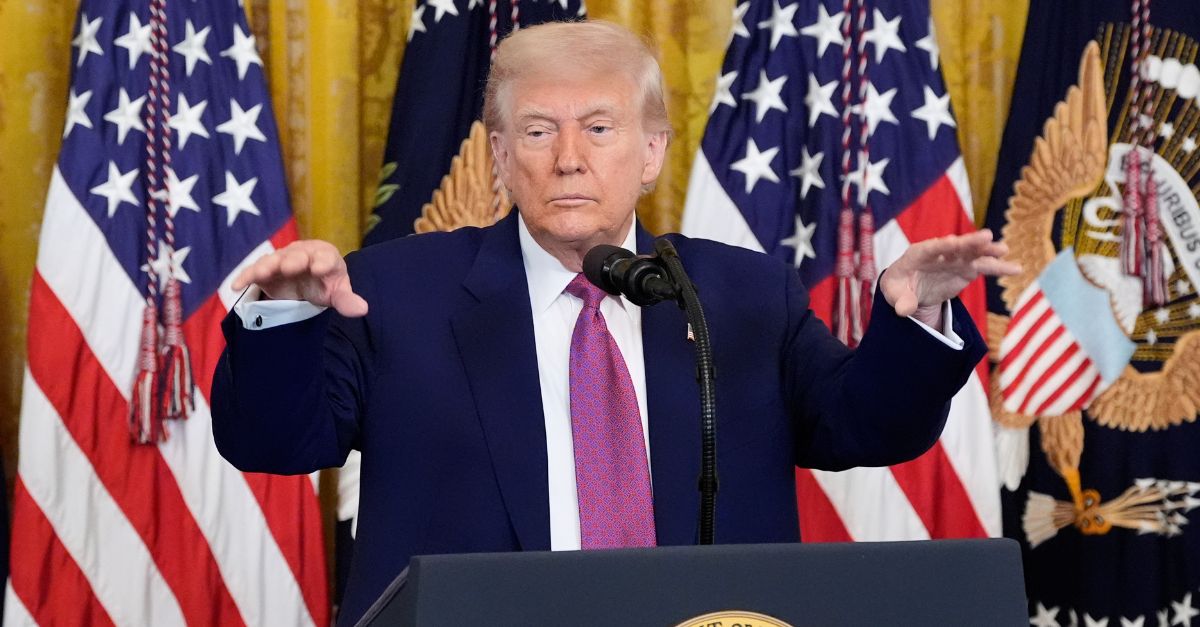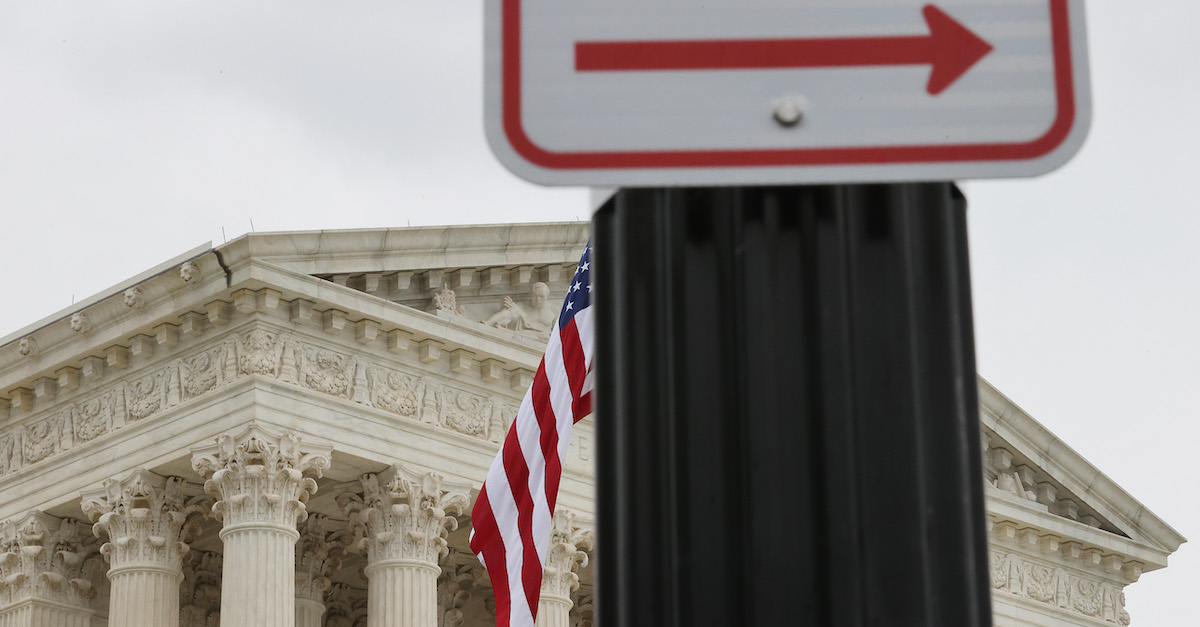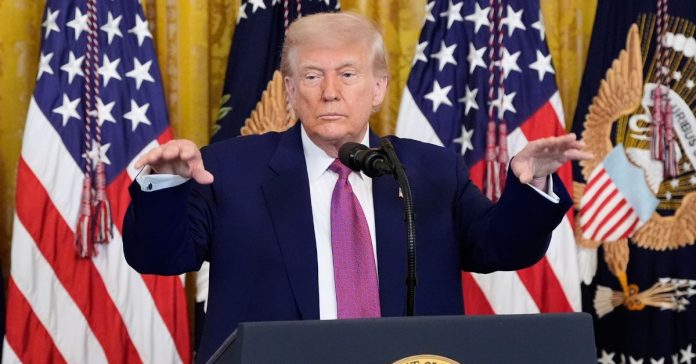
President Donald Trump speaks after signing a bill blocking California”s rule banning the sale of new gas-powered cars by 2035, in the East Room of the White House, Thursday, June 12, 2025, in Washington (AP Photo/Alex Brandon).
The influence of the U.S. Supreme Court’s so-called “shadow docket” is playing a key role in keeping a career bureaucrat from regaining her job after being fired by President Donald Trump earlier this year.
From October 2020 until early May of this year, Shira Perlmutter, an attorney, served as the register of copyrights and director of the U.S. Copyright Office within the Library of Congress. Upon her removal, Perlmutter was replaced with Deputy Attorney General Todd Blanche, Trump’s onetime personal criminal defense attorney in Manhattan.
In late May, Perlmutter filed a 14-page lawsuit in Washington, D.C., requesting a preliminary injunction to prevent her from being fired.
On Wednesday, in a 17-page memorandum opinion, U.S. District Judge Timothy J. Kelly, appointed by Trump during his first term in office, denied the plaintiff’s requested injunction “because she has not shown that she will be irreparably harmed without this relief.”
Buried under decades of precedent in the district court’s ruling is the high court’s majority opinion in a consolidated shadow docket case from late May that paved the way for the 45th and 47th president to remove Joe Biden-appointed members of the National Labor Relations Board (NLRB) and Merit Systems Protection Board (MSPB).
Love true crime? Sign up for our newsletter, The Law&Crime Docket, to get the latest real-life crime stories delivered right to your inbox.
While Kelly’s opinion stakes out territory on “irreparable harm” – a legal term of art which refers to a kind of injury that cannot be rectified with money – in cases dating all the way back to the 1960s, the judge takes several pages to get to the heart of his analysis.
Here, the judge is clear: the heart of the matter is what the justices did when the NLRB’s Gwynne Wilcox and MSPB’s Cathy Harris tried to get their jobs back by claiming Trump illegally fired them.
In that terse two-page opinion, in the case stylized as Trump v. Wilcox, the nation’s final court of appeal ruled in Trump’s favor. But while the majority referenced the merits of the case, the opinion expressly says the merits are not being considered – instead relying on the recitation of factors that go into staying injunctions.
“The stay reflects our judgment that the Government is likely to show that both the NLRB and MSPB exercise considerable executive power,” the unsigned opinion reads. “But we do not ultimately decide in this posture whether the NLRB or MSPB falls within such a recognized exception; that question is better left for resolution after full briefing and argument. The stay also reflects our judgment that the Government faces greater risk of harm from an order allowing a removed officer to continue exercising the executive power than a wrongfully removed officer faces from being unable to perform her statutory duty.”
In the aftermath of the Wilcox ruling, the U.S. Court of Appeals for the District of Columbia Circuit has repeatedly stayed injunctions in employment-related cases where federal employees claimed they were illegally fired.
Kelly recites this upshot as persuasive:
[W]hat happened next: either the D.C. Circuit or the Supreme Court stayed the injunctions entered by the district courts. In three, either the Circuit or the Supreme Court stayed a preliminary injunction directly. In the other two, the decision cited by Perlmutter was an unappealable temporary restraining order, but a subsequent permanent injunction entered by the same court was stayed. And while Perlmutter disputes the meaning of these developments in the appellate courts, this Court would have to blind itself to them to assign the weight to these cases that she urges. In the end, none of the injunctions stuck. And no precedent of the Supreme Court or the D.C. Circuit has recognized that an official’s temporary loss of a “statutory right to function” is an irreparable harm in a situation like Perlmutter’s[.]
The term “shadow docket” was coined by University of Chicago Law Professor William Baude in a 2015 law review article. Since then, it has been popularized by Georgetown University Law Professor Steve Vladeck, who penned a 2023 book on the subject.
The long and short of the criticism directed at the court’s use of the shadow docket is the dispensation of highly influential rulings – in real terms – in ways that do not contain much, if any, legal analysis. This, critics say, often results in victories for Trump and the GOP – or other conservative petitioners – without producing precedent. In fact, the unexplained nature of the non-merits docket intentionally cautions against reading into such decisions as precedential.
Part of the criticism is the decided uptick in use of the emergency application process – and the high court entertaining such requests.
During the first Trump administration, the federal government’s use of the shadow docket vastly outnumbered the combined use by both the Barack Obama and George W. Bush administrations. In his first four years, Trump’s DOJ filed 41 emergency requests; in the prior 16 years, two separate DOJs filed eight such requests. And, during Trump’s first term, the justices ruled in his favor 28 times on those requests.
Vladeck noted its recent use in an April blog post: “As you’ve likely noticed, we’ve received three major rulings from the Supreme Court in the last six days on emergency applications from the Trump administration, all of which granted the federal government’s underlying requests—albeit in ways that, in each case, assiduously avoided endorsing the government’s conduct on the merits.”
The term was used by Justice Elena Kagan herself in 2021 – in a dissent in a case about then-extant federal abortion rights.
In a dissent in a case earlier this month – about Trump’s ability to fire political appointees – Kagan took her colleagues to task over the use of the shadow docket to dismantle regulatory agencies.
“The majority has acted on the emergency docket—with ‘little time, scant briefing, and no argument’— to override Congress’s decisions about how to structure administrative agencies so that they can perform their prescribed duties,” the dissent reads. “By means of such actions, this Court may facilitate the permanent transfer of authority, piece by piece by piece, from one branch of Government to another.”
Several other such shadow docket rulings have been issued in the Trump administration’s favor this year. While a substantial number have stayed injunctions in employment-related cases, there have been anti-immigration rulings on the shadow docket as well.

The U.S. Supreme Court offset against a right arrow sign (Chip Somodevilla/Getty Images).
In the present case, the judge sticks to the employment angle.
“The reasoning behind the orders staying the injunctions, even if not conclusive here, is instructive as to whether Perlmutter is suffering the kind of harm warranting preliminary injunctive relief, especially in light of the balance of the equities,” Kelly writes – viewing the issue as a way to deal with injunctions where both sides claim vast harms.
While Kelly seems to be seeing something not entirely unlike a precedent – at least in terms of civil procedure as it relates to injunctive relief – other district courts have gone the other way.
Last week, U.S. District Judge Loren AliKhan, a Joe Biden appointee who sits on the same court as Kelly, directly rejected the idea the justices had created any kind of precedent with the Wilcox ruling.
In all of the employment cases, a great deal of the merits analysis is focused on a 1935 Supreme Court opinion about limitations on the president’s ability to fire appointed officials at will. The case in question, Humphrey’s Executor v. U.S., stands for the idea that Congress intended to keep “quasi judicial and quasi legislative” agencies largely insulated from the whims of the president.
AliKhan goes to bat for the actual precedent, at length:
[U]nless the Supreme Court expressly overrules Humphrey’s Executor, which speaks directly to removal protections for FTC Commissioners, this court will not usurp the Supreme Court’s “prerogative . . . to overrule one of its [own] precedents.” Even when a lower court believes that existing “precedent is in tension with some other line of decisions,” it cannot unilaterally assume that established law has been “implicitly overruled.” Until the current Supreme Court speaks clearly as to the fate of Humphrey’s Executor, this court cannot—and will not—presume that a ninety-year-old ruling is no longer good law.
AliKhan’s defense of Humphrey’s Executor comes in the context of the Trump administration’s reliance on the shadow docket to stay injunctions – while the justices have avoided the merits. But addressing the merits would necessarily require dealing with Humphrey’s Executor.
“[T]he Supreme Court’s stay order was an initial, four-paragraph assessment of two complicated cases without ‘full briefing and argument,'” AliKhan went on. “The Court expressly ‘d[id] not ultimately decide . . . whether the NLRB or MSPB falls within . . . a recognized [Presidential-removal] exception.’ This court will not turn a preliminary determination (about agencies not at issue here) into a license to contravene Supreme Court precedent that has stood for almost a century.”
Despite the discord over how to interpret shadow docket rulings, what the Supreme Court does – and often does not say – has a substantial impact on how lower courts are dealing with executive power.

